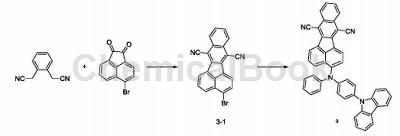Background and overview[1][2]
Phthalodiacetonitrile is an organic compound that can be prepared from dibromo-o-xylene and is used to prepare organic electroluminescent materials.
Preparation[1]

To a solution of sodium cyanide (2.0g, 40.8mmol) in 25mL of water was added a suspension of α,α’-dibromo-o-xylene (4.3g, 16.3mmol) in 50mL of ethanol. The mixture was refluxed for 2 hours and the clear solution was cooled to ambient temperature and concentrated. Extract with three portions of dichloromethane, and the combined organic layers are dried with MgSO4, filtered and concentrated to obtain dinitrile, 70% crude yield: Rf 0.23 (30:70 acetone/hexane); IR (cm -1): 3362,3067,2928,2250,1625,1495,1455,1417,751; 1 H NMR (250MHz, C6D6) δ2.52 (s, 4H), 6.81 (m, 2H), 6.94 (m, 2H).
Apply[2]
Phthalonitrile can be used to prepare organic electroluminescent materials.
Organic electroluminescence refers to the phenomenon that organic materials emit light when excited by current and electric field under the action of electric field. Organic electroluminescent diodes (OLEDs) are a new generation of display technology that utilizes this phenomenon to achieve displays. Since Tang C.W. and Vanslyke S.A. of Kodak Company in the United States produced the first organic electroluminescent device with excellent performance in 1987, organic electroluminescent displays have aroused great interest due to their advantages. Fused ring compounds are a commonly used blue-light emitting material. However, currently common anthracene materials have unsatisfactory luminescent properties, characterized by low luminous efficiency and high driving voltage. How to design new host materials with better fused ring structures has always been an urgent problem for those skilled in the art.
CN201711098518.3 provides an organic electroluminescent material and an organic light-emitting device thereof. The organic light-emitting device prepared by using the organic electroluminescent material of the present invention has higher luminous efficiency and lower driving voltage. The present invention first provides an organic electroluminescent material, the general structural formula of which is shown in I:

Beneficial effects of the present invention: The organic electroluminescent material structure of the present invention contains a structure with cyanofluoranthene, and the five-membered ring structure contained therein can effectively interrupt the conjugated structure and the triplet state The energy level is higher and it is more suitable as a host material. Connected with carbazole and phenothiazine groups to form a bipolar transmission body, which can better balance carrier transmission. Compared with the existing technology, when it is applied to organic light-emitting devices, especially when used as a host material in the light-emitting layer, it has relatively high luminous efficiency and low driving voltage.
Main reference materials
[1] PCT Int. Appl., 2011041349, 07 Apr 2011
[2] CN201711098518.3 An organic electroluminescent material and its organic light-emitting device

 微信扫一扫打赏
微信扫一扫打赏

